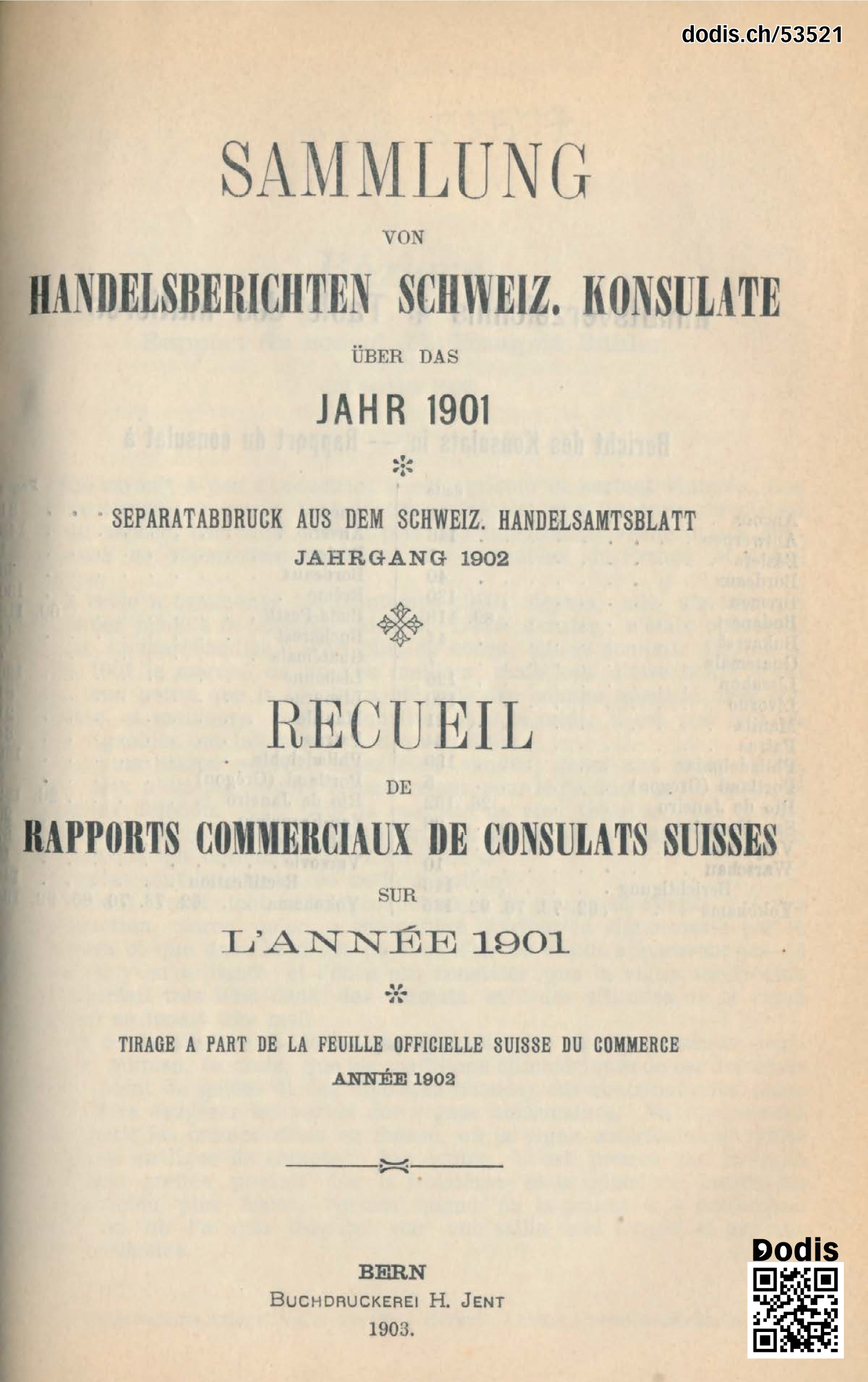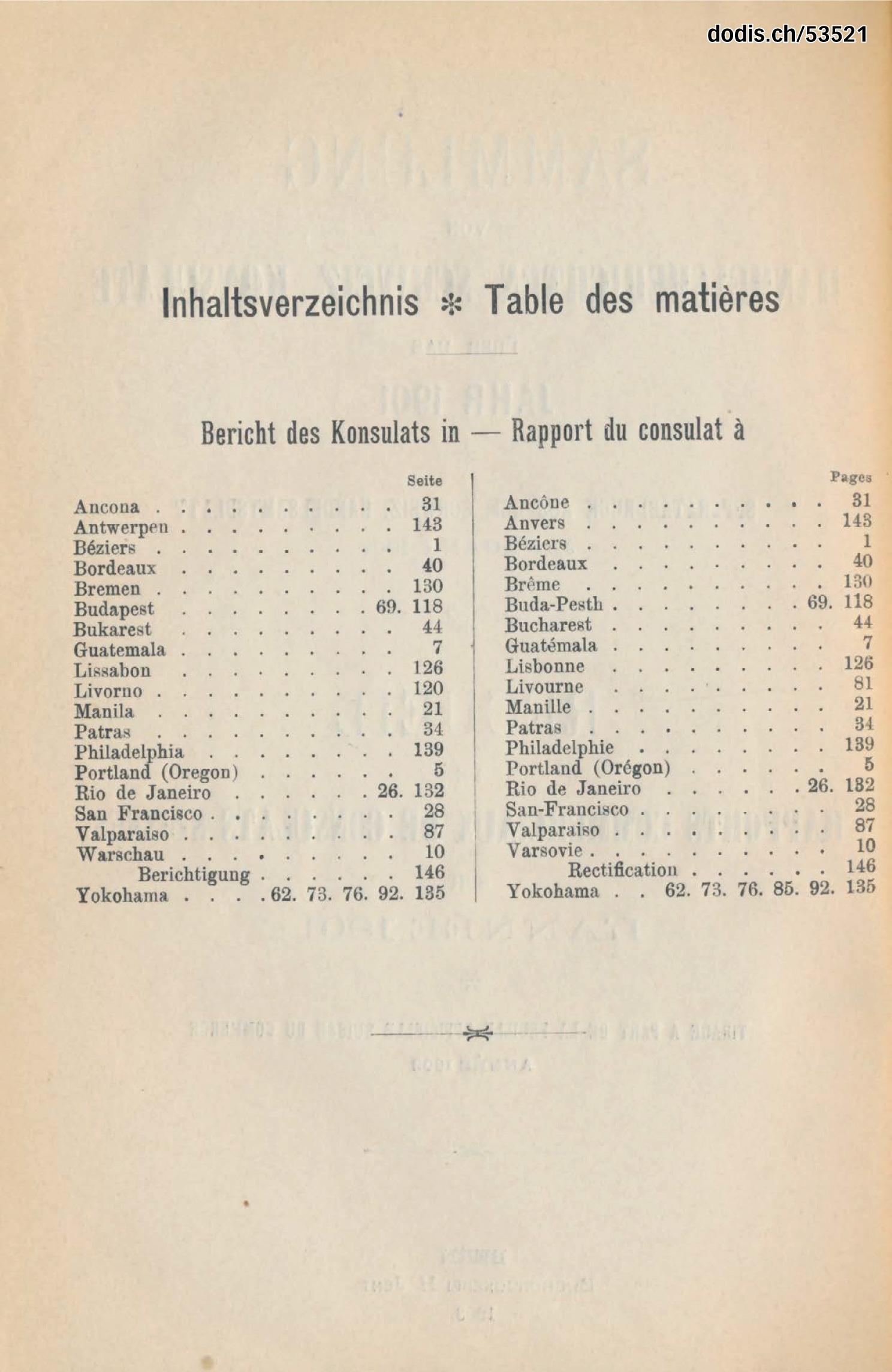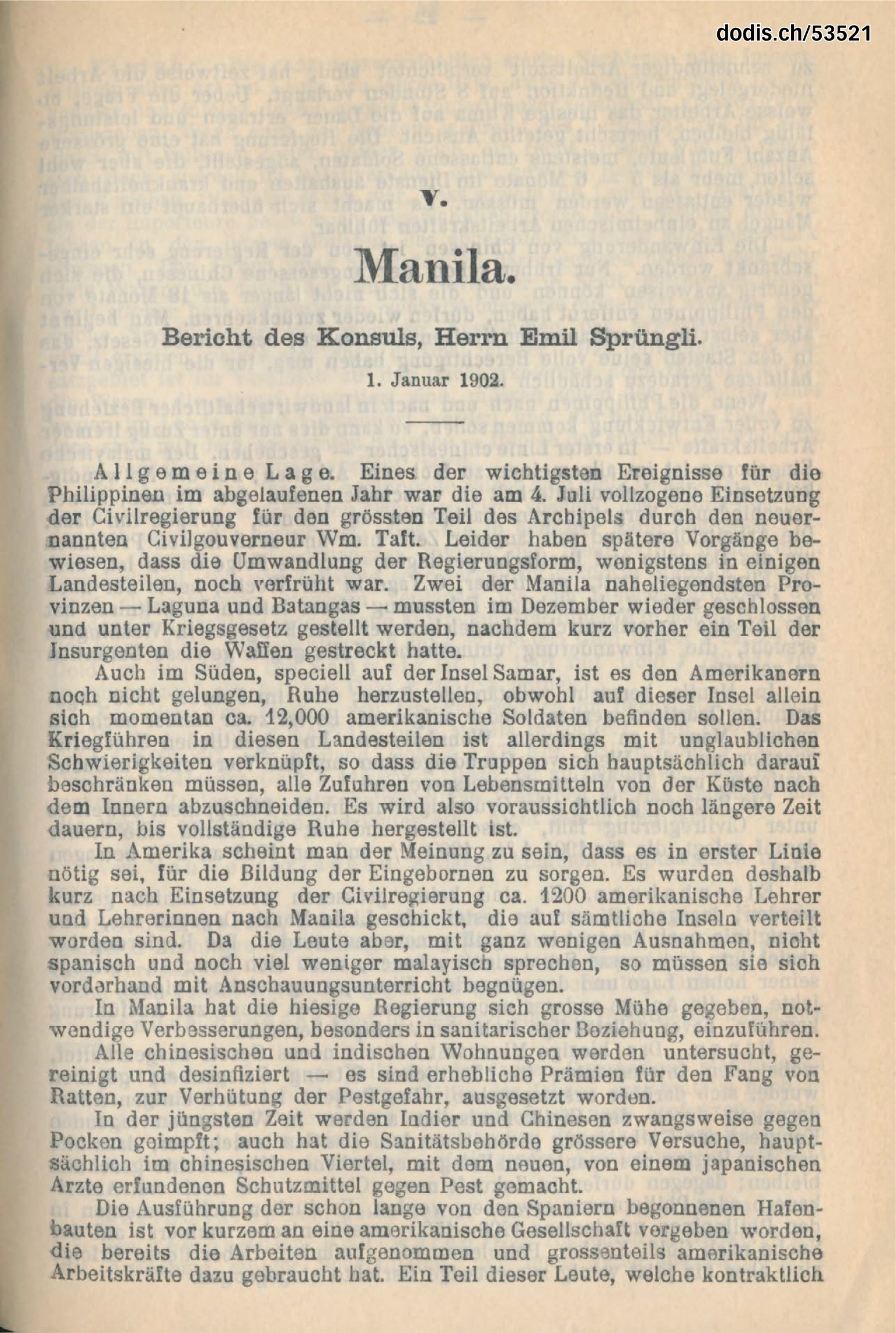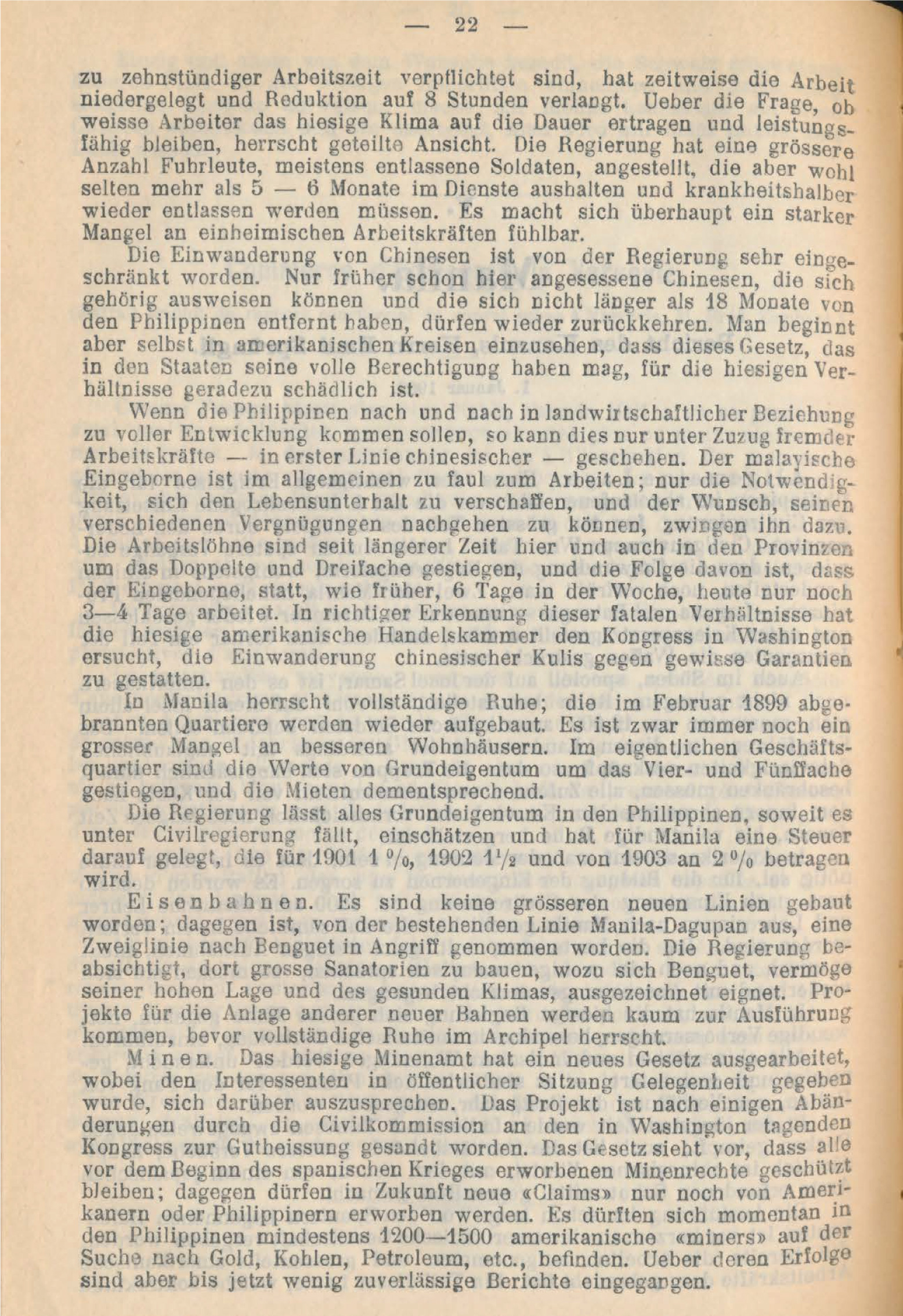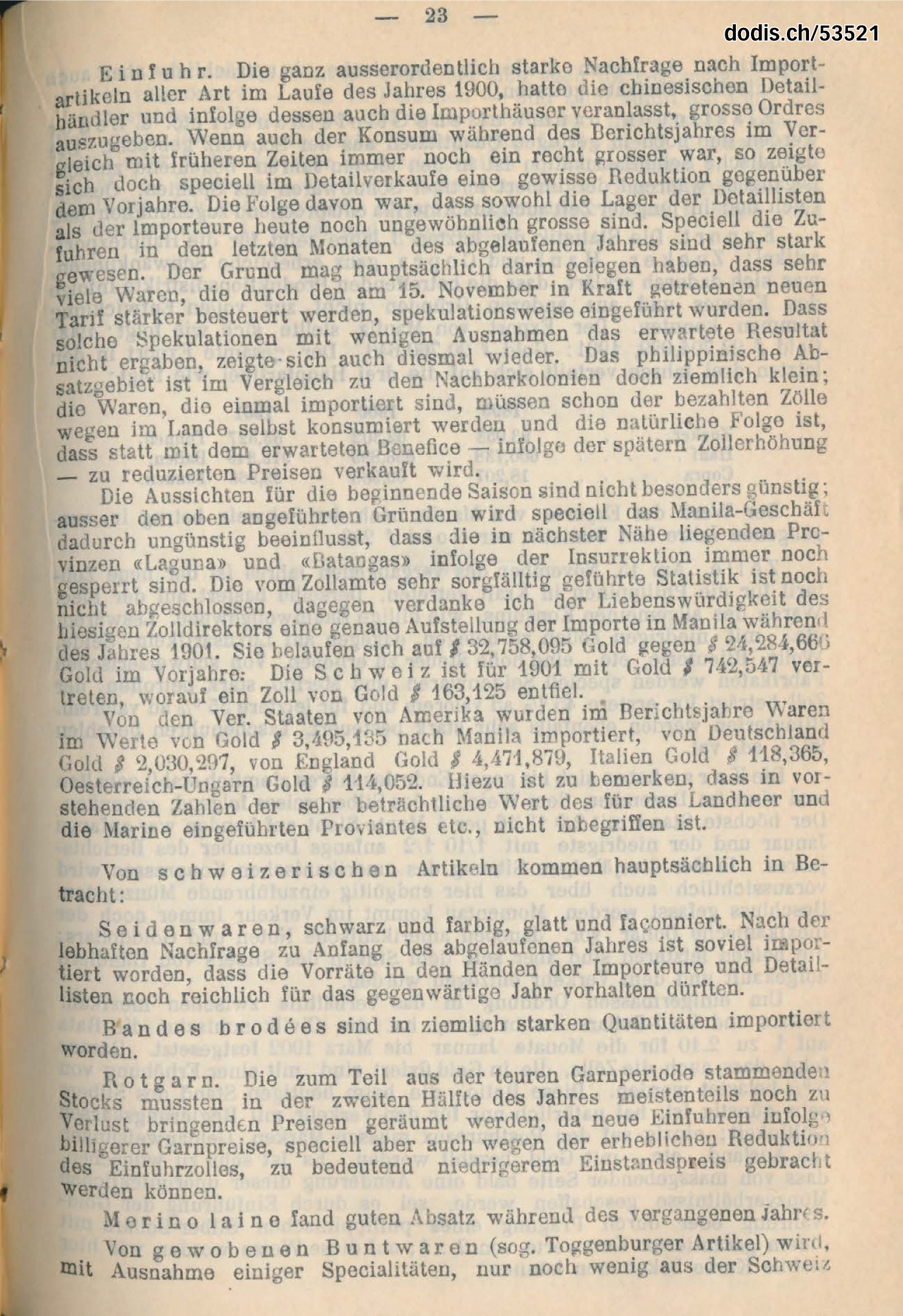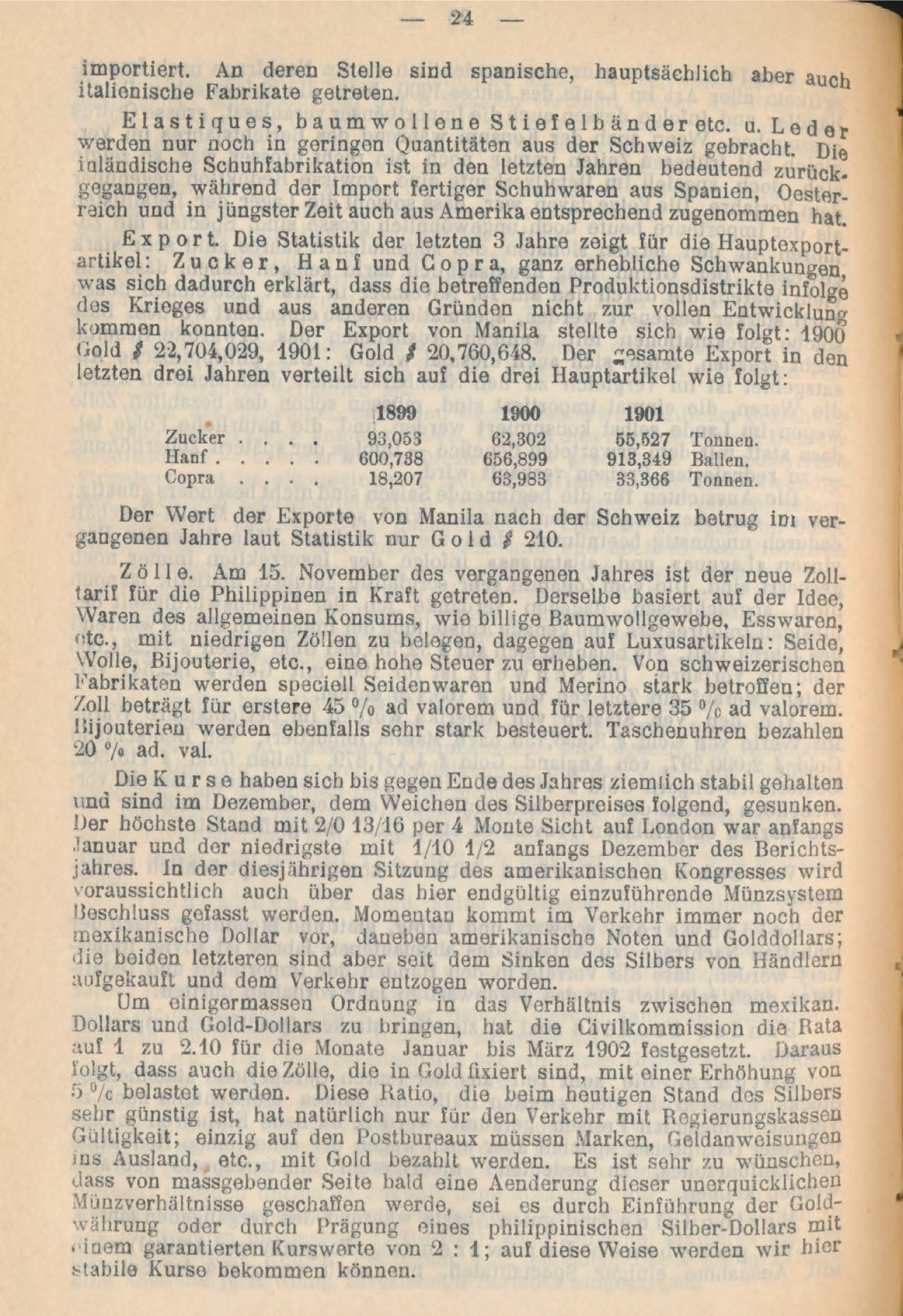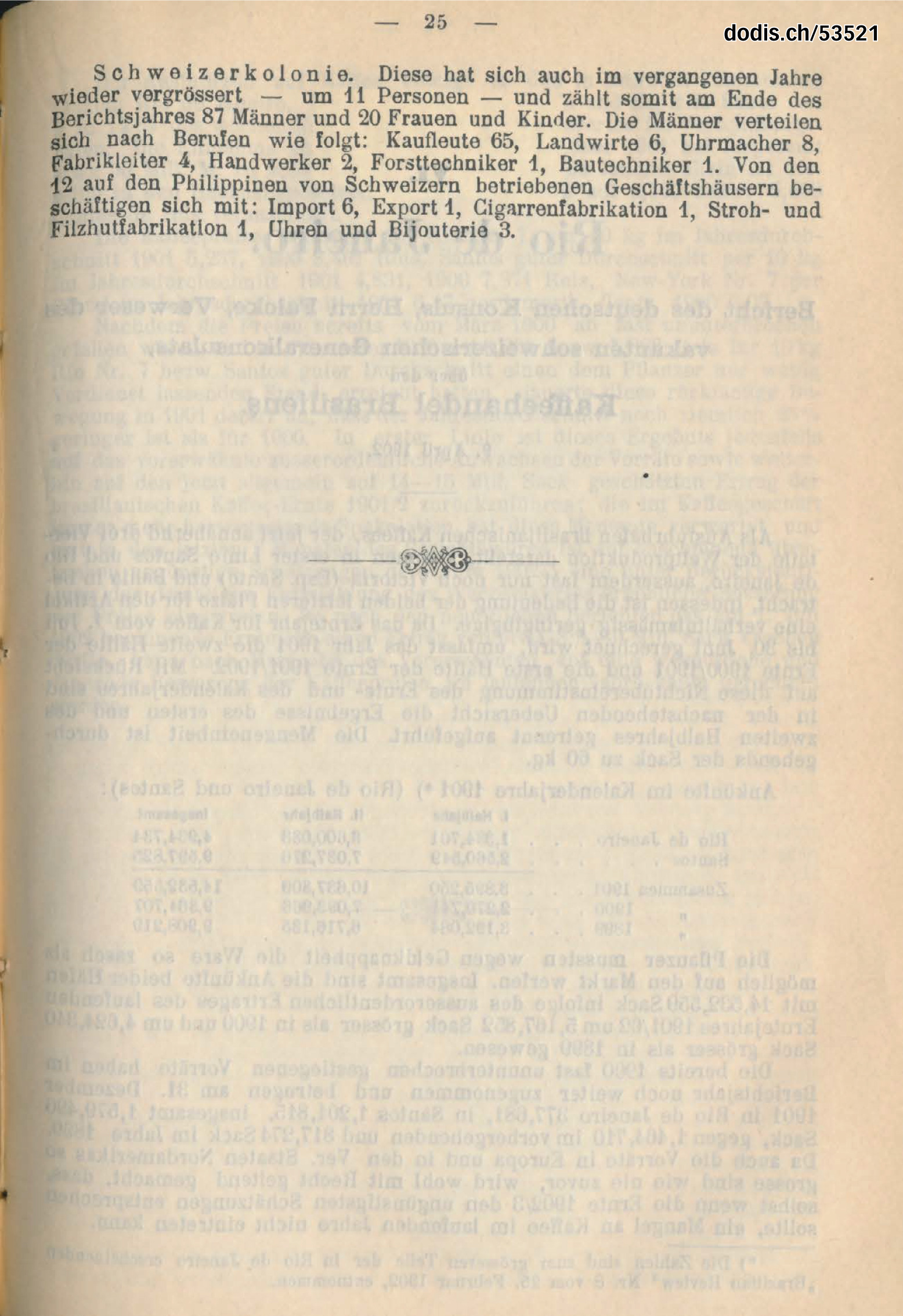Manila. Report of the Consul, Mr. Emil Sprüngli. January 1, 1902
From the Trade Reports of the Swiss Consulates (1893–1904), submitted by Sprüngli, Emil (1851–1910), the honorary Swiss consul to the Philippines from 1882–1910. The text has been translated from German by Stephanie Willi. Source: The Diplomatic Documents of Switzerland (Dodis) https://dodis.ch/P20525?lang=en
V.
Manila.
Report of the Consul, Mr. Emil Sprüngli.
January 1, 1902.
General Situation. One of the most important events for the Philippines during the past year was the establishment of civil government on July 4 for most of the archipelago by the newly appointed civil governor, Wm. Taft. Unfortunately, later events proved that the transformation of the form of government, at least in some parts of the country, was premature. Two of the provinces closest to Manila - Laguna and Batangas - had to be closed again in December and placed under martial law, shortly after some of the insurgents had laid down their arms.
The Americans have also not yet succeeded in establishing calm in the south, especially on the island of Samar, although this island alone is said to be home to some 12,000 American soldiers at present. However, waging war in these parts of the country is fraught with incredible difficulties, so that the troops must confine themselves mainly to cutting off all supplies of food from the coast to the interior. It will therefore probably be some time before complete calm is established.
In America, the opinion seems to be that it is primarily necessary to provide for the education of the natives. Therefore, shortly after the establishment of the civil government, about 1200 American teachers were sent to Manila and distributed among all the islands. However, since the people, with very few exceptions, did not speak Spanish and even less Malay, they have to make visual instruction for the time being.
In Manila, the local government has taken great pains to make the necessary improvements, especially in the sanitary field. All Chinese and Indian [natives] homes are being inspected, cleaned and disinfected - substantial premiums have been offered for the capture of rats, to prevent the danger of plague.
Recently, Indians [natives] and Chinese have been compulsorily vaccinated against smallpox; also, the sanitary authorities have made larger experiments, mainly in the Chinese quarter, with the new protective agent against plague invented by a Japanese physician.
The construction of the harbor, long begun by the Spaniards, has recently been entrusted to an American company, which has already begun work, using mostly American labor. Some of these people, who are contractually
obliged to work ten hours a day, have temporarily stopped work and demanded a reduction to eight hours. Opinions are divided as to whether white workers can tolerate the local climate and remain productive in the long term. The government has employed a large number of wagoners, mostly discharged soldiers, who rarely last more than 5-6 months in the service and have to be dismissed due to illness. There is a noticeable shortage of local labor.
The immigration of Chinese has been very restricted by the government. Only Chinese who have been here before, who can prove their identity and who have not been away from the Philippines for more than 18 months, are allowed to return. Even in American circles, however, it is beginning to be recognized that this law, which may have its full justification in the States, is downright harmful for conditions here.
If the Philippines are to gradually achieve full development in agricultual terms, this can only happen with the influx of foreign labor, primarily Chinese. The Malay native is generally too lazy to work; only the necessity of earning a living and the desire to pursue his various pleasures compel him to do so. Labor wages here and in the provinces have for some time been doubled and trebled, and the result is that the native, instead of working 6 days a week, as formerly, now works only 3-4 days.
In proper recognition of these fatal conditions, the American Chamber of Commerce here has petitioned Congress in Washington to permit the immigration of Chinese coolies in return for certain guarantees.
Complete tranquility prevails in Manila; the quarters burned in February 1899 are being rebuilt. Even though there is still a great lack of better dwellings. In the business district, real property values have increased four and five times, and rents accordingly. The government is having all real property in the Philippines, so far as it falls under civil government, assessed, and has placed a tax on it for Manila, which will be 1% for 1901, 1 ½ in 1902, and 2% from 1903 on.
Railroads. No major new lines have been built; on the other hand, a branch line to Benguet has been started from the existing Manila-Dagupan line. The government intends to build large sanatoriums there, for which Benguet, due to its high location and healthy climate, is excellently suited. Projects for the construction of other new railroads are unlikely to be carried out until complete tranquility prevails in the archipelago.
Mines. The local Mines Office has drafted a new law, and interested parties were given an opportunity to speak on it at a public meeting. The project, after some amendments by the Civil Commission, has been sent to Congress, which had a meeting in Washington, for approval. The law provides that all mining rights acquired before the beginning of the Spanish war will remain protected; on the other hand, new "claims" may only be acquired by Americans or Filipinos in the future. At the moment there are probably at least 1200-1500 American miners in the Philippines searching for gold, coal, petroleum, etc. The success of these miners is still unknown.
Import. The extraordinarily strong demand for imported goods of all kinds in the course of 1900 had caused Chinese retailers and, as a result, import houses to issue large orders to spend large sums. Although consumption during the year under review was still quite high compared to earlier periods, retail sales in particular showed a certain reduction compared to the previous year. As a result, the stocks of both retailers and importers are still unusually large. In particular, deliveries in the last few months of the past year have been very strong.
The main reason may have been that a large number of goods, which will be taxed more heavily under the new tariff that came into force on November 15, were imported on a speculative basis. That speculation, with few exceptions, did not produce the expected result, has been shown also this time.
The Philippine sales area is rather small compared to the neighboring colonies; the goods, once imported, must be consumed in the country itself because of the duties paid, and the natural consequence is that instead of the expected benefit, they are sold at reduced prices as a result of the subsequent increase in duties.
The prospects for the beginning season are not particularly favorable. In addition to the above-mentioned reasons, the Manila business in particular is unfavorably affected by the fact that the nearby provinces of Laguna and Batangas are still closed as a result of the insurrection.
The statistics, which are very carefully kept by the customs office, are not yet complete, but I am indebted to the kindness of the Customs Director here for an exact statement of the imports into Manila during the year 1901.
Amounting to $ 32,758,095 gold against $ 24,284,666 gold in the preceding year: Switzerland is represented for 1901 with gold $ 742,547, on which there was a duty of gold $ 163,125.
From the United States of America goods to the value of gold $ 3,495,135 were imported into Manila in the year under report, from Germany gold $ 2,030,297; from England gold $ 4,471,879; Italy gold $ 118,365, Austria-Hungary gold $ 114,052. It should be noted that the above figures do not include the very considerable value of provisions, etc., imported for the land army and navy.
Of Swiss articles, the main ones are: silk goods, black and colored, plain and faceted. After the lively demand at the beginning of the past year, so much has been imported that the stocks in the hands of importers and retailers should still be ample for the present year. Band brodées have been imported in fairly strong quantities.
Red yarn. In the second half of the year, most of the stocks originating from the expensive yarn period had to be cleared at loss-making prices, as new imports can be brought in at significantly lower cost prices due to cheaper yarn prices, but especially due to the considerable reduction in import duty.
Merinolaine found good sales during the past year. Except for a few specialties, very little woven colorful goods (so-called Toggenburg articles) are imported from Switzerland.
Spanish, but mainly Italian products have taken their place.
Elastiques, cotton boot straps, etc., and leather are now only imported in small quantities from Switzerland.
Manila's exports were as follows: 1900 Gold $ 22,704,029, 1901: Gold $ 20,760,648. The total export during the last three years is distributed among the three principal articles as follows:
| 1899 | 1900 | 1901 | ||
|---|---|---|---|---|
| Sugar | 93,058 | 62,302 | 55,527 | Tonnen |
| Hemp | 600,738 | 656,899 | 913,349 | Bales |
| Copra | 18,207 | 63,983 | 33,366. | Tonnen |
The value of exports from Manila to Switzerland during the past year, according to statistics, was only gold $210.
Duties. On November 15 last year, the new customs tariff for the Philippines came into force. It is based on the idea of imposing low tariffs on goods of general consumption, such as cheap cotton fabrics, foodstuffs, etc., and high taxes on luxury articles such as silk, wool, costume jewelry, etc., in contrast. Of Swiss manufactures, especially silk goods and merino will be strongly affected; the duty for the former is 45% ad valorem and for the latter 35% ad valorem.
Bijouteries are also very heavily taxed. Pocket watches pay 20 % ad. val.
Rates held fairly steady until near the end of the year, falling in December following the softening of the silver price.
The highest at 2/0 13/16 as of 4 Monte sight in London was at the beginning of January and the lowest at 1/10 1/2 at the beginning of December of the year under review. This year's session of the U.S. Congress is also expected to decide on the coinage system to be finally adopted here.
At present, the Mexican dollar is still in circulation, along with American notes and gold dollars; the latter two, however, have been bought up by dealers and withdrawn from circulation since the fall of silver.
In order to bring some order to the relationship between Mexican dollars and gold dollars, the Civil Commission has fixed the rata at 1 to 2.10 for the months of January to March 1902. It follows that duties fixed in gold will also be subject to a 5% increase. This ratio, which is very favorable at the present state of silver, is of course valid only for transactions with government treasuries; only at the post bureaux must stamps, money orders abroad, etc., be paid in gold. It is very much to be wished, that a change in these unpleasant coinage conditions will soon be created, either by introducing the gold currency or by minting a Philippine silver dollar with a guaranteed exchange rate of 2:1; in this way we will be able to obtain stable exchange rates.
Swiss colony. This colony has increased again in the past year - by 11 persons - and at the end of the year under report counts 87 men and 20 women and children. The men are distributed by profession as follows: Merchants 65, Farmers 6, Watchmakers 8, Factory Managers 4, Craftsmen 2, Forestry Technicians 1, Construction Technicians 1. Of the 12 business houses operated by Swiss in the Philippines they are dealing with following businesses: Import 6, Export 1, Cigar Manufacture 1, Straw and Felt Hat Manufacture 1, Watches and Bijouterie 3.
Translated from German, May 2023, Stephanie Willi
